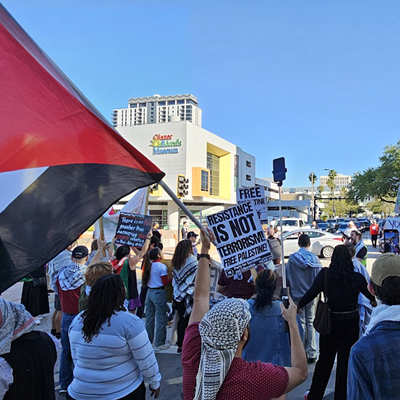
The Planet begins its series on these shifting urban landscapes with a glimpse into the weekday life of downtown Tampa and St. Pete.
Two downtowns. Two distinct identities. Twenty-four miles from one another, yet worlds apart.
Tampa is tall, gleaming and full of commerce. St. Petersburg is squat, inviting and full of tourists.
Tampa is dead at night. If more than a few dozen people are downtown on any given evening — outside of a show at the Tampa Bay Performing Arts Center — they are doing one helluva job hiding.
St. Petersburg's nighttime scene is alive. Bands rock Jannus Landing. Theater fills a park for an outdoor performance. Glassy-eyed 20-somethings stumble from the Independent to Mastry's and back as they take in drinks and sexual partners.
The two downtowns do have one thing in common: The condo boom.
The popularity of buying condominiums over the past decade — as investment or as domicile — has led to plans for an unprecedented number of new residential units in both downtowns. The prices range from the affordable ($170,000) to the luxurious (more than $1.7 million to hang your hat at Trump Tower Tampa; $4 million for the penthouse at Signature in St. Petersburg).
With the condo boom come challenges.
For Tampa, the question is whether a residential neighborhood can be created in a downtown that currently empties at 5 p.m. For St. Petersburg, the issue is one of integration; adding expensive condos (and their thousands of residents) to a functioning downtown could change its bohemian flavor and raise property values out of reach of the arts groups and small businesses that give the city its distinctiveness.
A desirable downtown can help forge a city's identity and provide an important urban core for a metropolitan region. And Tampa Bay has the kind of populace that would seem drawn to such a core: According to a May 2006 Impresa study done for Creative Tampa Bay, we have far fewer jobs in manufacturing than do most other urban areas. Our strong employers (outside of service and tourism) are the banking and insurance companies that make up the lifeblood of downtowns.
Yet that same study suggests a disconnect between what the two cities are striving for and what many residents want. The study found that Tampa Bay residents ranked 37th out of 50 metropolitan areas among those who would rather live in the city than in the suburbs.
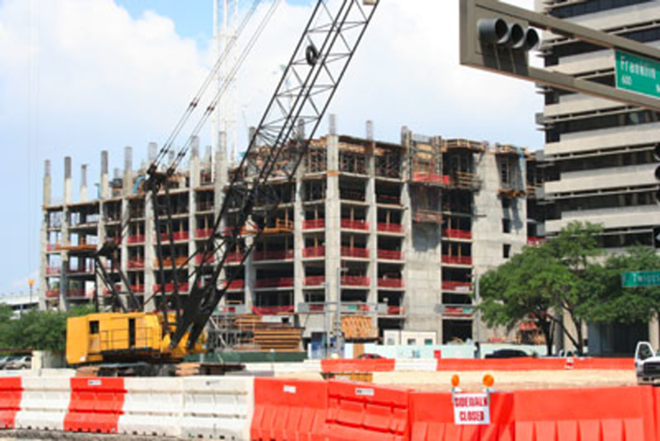
This week the Planet begins an ongoing look at the problems and possibilities arising in these two "Downtowns on the Verge." Think of this initial story as a collection of impressions — our attempt to take the temperature of the two downtowns on an average working day. On two recent mid-week afternoons, the entire editorial staff fanned out, first in Tampa and then in St. Pete, to experience the state of the city in such areas as condo growth, transportation and parking, arts and culture, downtown living, dining, the waterfront, and life along Central and Franklin.
Here is what we found on those two days in May, before the heat of summer set in.
THE "MAIN" STREETS
At a pedestrian glance, the respective daytime personae of Tampa's Franklin Street and St. Petersburg's Central Avenue — the thoroughfares that, in the classic urban sense, serve as each downtown's spine, center of activity, promenade — couldn't be more different.
Beginning at Tampa City Center's smoked-glass modernity, Franklin Street's brick-paved mall runs only half a dozen blocks of skyscraper-walled canyon before petering out amid a cluster of condos-in-progress, empty storefronts, the Hillsborough Regional Services Center and the first signs of decaying peripheral sprawl. By day, the northernmost two blocks are peopled only by construction workers and those returning to their cubicles from grabbing lunch; the only current potential magnet for leisure, Herman Massey Park, sits going to seed behind locked fence gates. Southward, things are positively bustling. Suit-clad cubicle denizens briskly cruise the sidewalks in packs, chatting on cell phones. They grab hot dogs or gyros at several food carts, or steam in and out of myriad restaurants that stretch the definition of the word "deli." They sit one-to-a-bench in Gaslight Square Park, reading supermarket checkout-aisle novels, or half-glance into the windows of the few shops not selling chow or convenience.
But only until 1:30, when what could only graciously be called "the crowd" disappears completely, back into the handful of high-rise hives until the working day is done.

St. Pete's Central Avenue, on the other hand, retains various degrees of vitality all the way to the Treasure Island Causeway, at the peninsula's western shore. Downtown, Central's low-slung, wildly varying architecture (modern, Mediterranean, classic Florida, downright old) strongly contrasts with Tampa's urban heart. St. Pete's center has its share of empty storefronts, too, but its eclectic old-school-beach-town assortment of restaurants, bars, antique boutiques and specialty shops sustains an all-day flow of tourists, errand-runners, shoppers and gawkers. The density unarguably lessens after the lunch-hour rush, but couples remain lazily grazing at outdoor tables all afternoon. Gaggles of consumers stroll from window to window, and soccer moms fill Central's metered parking lots in the name of paying the utilities. Each of its four or so bars serves more grizzled retirees and parched locals than downtown Tampa's sole populist watering hole, The Hub.
But a closer look finds more commonality between these two streets than one might expect. Both Franklin and Central are trying to provide an alternative to the time-honored American notion that downtown is for business and the suburbs are for living (and shopping) — and both are suffering for it. Central Avenue's funky charm may attract dedicatedly individual consumers, but it's no more a match for Wal-Mart than the CVS Pharmacy on Franklin Street is. Both are constantly dealing with the issues of growing up, as it were, within an area that's tiny compared with the larger metropolitan regions that they are often measured against.
Perhaps most importantly, both seem to be the result of an organic evolution — a gradual adaptation to the needs of their environments. At present, Franklin Street has come to serve, almost exclusively, the short-term daytime needs of a workforce that lives and plays elsewhere; Central Avenue is busier, and offers a wider array of time- and money-consuming options, only because fewer people work there, more people live nearby, and more of them spend time downtown while the sun is up.
Both provide the services their communities have asked of them. It remains to be seen if concerted efforts to force sea changes in their respective characters will have positive or negative results. Or if such a thing can be done at all.
LIVIN' IN THE CITY
It's hard to live downtown in most cities — scarce parking, high rents, lack of Wal-Mart Supercenters.
In Tampa, it is nearly impossible.
The majority of restaurants in downtown Tampa are open only for lunch and only Monday through Friday; the options for dinner are limited, with Spain Restaurant on Tampa Street being one welcome exception. The Thai Corner, a new addition to the downtown dining scene, had hoped to take advantage of the dearth of dinner opportunities by remaining open at night and on Saturdays, but saw little business and scaled back its hours. (Co-owner Rungthip Uttankanchana hopes to see improvement once the condo units are occupied.)
All the small markets and magazine stands close soon after commuters start their trek home. Even the CVS on Franklin Street closes by 6 p.m. Every night, and weekends, the city's core is eerily quiet. And, at least for the time being, living options outside of the Channel District are limited to the One Laurel Place condominiums, the retiree-enclave of Methodist One, or Central Park Village public housing on downtown's eastern outskirts. The mixed-use development so common now in U.S. downtowns — loft spaces above, retail shops below — is almost nonexistent.
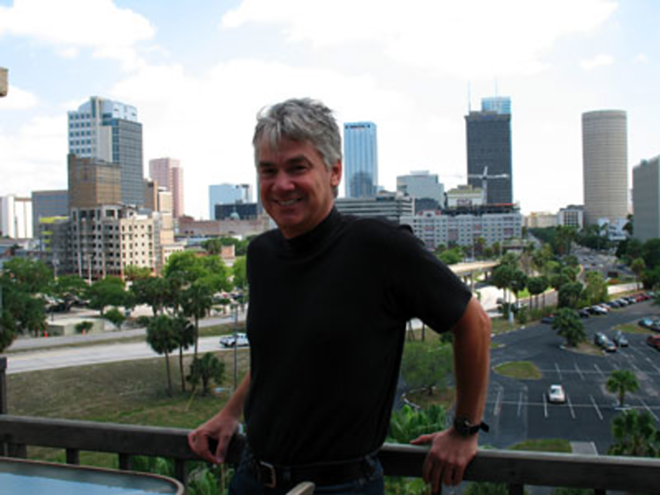
For Scott Gunderson, downtown Tampa's lack of, well, everything doesn't bother him. When he moved to the city's core in 1995, proximity to the Performing Arts Center or the Times Forum was not a factor. He didn't mind that there were no grocery stores or restaurants with dinner menus. He was just tired of driving to work.
"I live here because I don't want to commute," says Gunderson, a 10-year resident of One Laurel Place who works as a freelance production manager for local ad agencies. "I don't want to drive to work and deal with the hassle."
Gunderson says condo developers and city officials should tout this aspect more than the promise of upcoming amenity projects, like the Riverwalk, to bring in prospective residents. People will move here without the amenities, he says. Then the supporting businesses will follow. (Tampa officials agree; they've said it will be five years after new condos open before retail will catch up to the influx.)
"People don't move to Carrollwood because they live close to a Chili's," he says. "I can get in a car and drive someplace to get what I need."
Gunderson, however, is well aware of St. Petersburg's advantages. "I'm jealous of St. Pete," he admits. "I think they have the jumpstart on the lifestyle down there."
From multi-family homes off of Fourth Ave. N. to the condos towering above Jannus Landing, St. Petersburg has a real residential neighborhood in its downtown. Restaurants like Fortunato's or bars like Mastry's can count on business from downtown dwellers as much as visitors. Popular spots like Ceviché, Café Alma, Bella Brava and the restaurants at BayWalk are busy each night, some serving late all week long. And where Tampa's downtown arts scene is quiet in the daytime except for the Tampa Museum of Art, the cultural offerings in St. Pete — the Museum of Fine Arts, Salvador Dalí Museum, Florida Holocaust Museum, The Arts Center, Florida International Museum and the St. Petersburg Museum of History — are alive and accessible through the day and often into the evening.
For the moment, at least, downtown's residents aren't homogeneous; high-rolling condo owners and lower-income working families co-exist, and enjoy equally the ease of an environment where everything's close by.
One renter, peering from his $400 efficiency apartment on the north side of Martin Luther King Jr. Street, says he doesn't even have to leave his street. Within two blocks, there is everything he'd ever need: Save-A-Lot, Molly's Bar and a bus stop.
ON THE WATERFRONTS
Relaxing on a shaded park bench with a view of St. Petersburg's picturesque marina, retiree Jerry Small sums up the difference between Tampa and St. Pete:
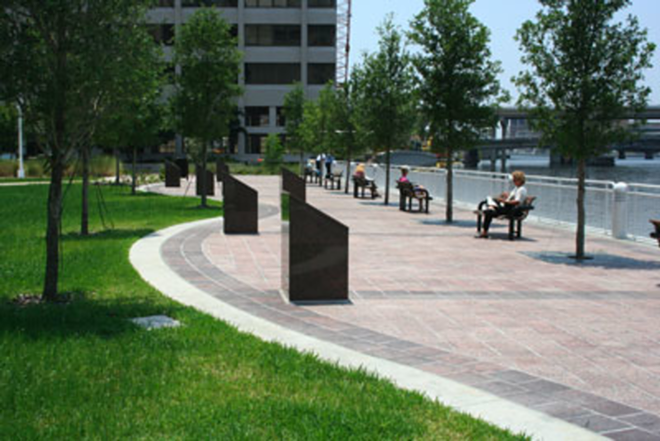
"Tampa's trying to create a waterfront. We have it."
He's right. St. Pete's waterfront is an integral downtown amenity, while Tampa's is still on the periphery, geographically as well as psychologically. Tampa's is on an environmentally damaged river; St. Petersburg's runs along the shores of an expansive Tampa Bay. Tampa's waterfront has an industrial past that morphed into skyscrapers, hotels, parking garages and other buildings that acted as a barrier; St. Pete's waterfront is protected from development by city laws requiring voter approval for any projects there.
The walkway behind Tampa's Marriott Waterside comes as a surprise to David Powell. A Cincinnati banker taking a break from an IBM software conference, Powell has been to the region some 30 times before, and this is the first time he's ever been to the river. He is impressed, sort of: "I like this better than the other parts of the Tampa I've visited."
Which should make Mayor Pam Iorio feel a little better, given that she's made the $40 million Riverwalk her legacy project.
A significant amount of the Riverwalk-in-progress is already walkable. You can follow the path that winds through Cotanchobee-Fort Brooke Park and proceed past the Marriott to the Convention Center Boating Facility (with its "Manatee Basics for Boaters" sign) without a break. After that, the path is broken up by bridges, between which you'll find a weird little park devoted to USF; a sun-scorched plaza called MacDill Park on the Riverwalk; and the promenade that runs past now-sad Kiley gardens, the Art Museum and Curtis Hixon Park.
But until the bridge interruptions are dealt with (the city plans to go under them with walkways floating out into the river), the Riverwalk will never have the unity, or the accessibility, of St. Pete's long meander. And the retail and restaurant presence that Riverwalk planners dream of is still just that — a dream. For now, the walkway's regulars are lunchtime pioneers, people like Scott Baylark, an ops supervisor with KPMG who treks from his office in the AmSouth building to a pocket park near the river and the Brorein Street Bridge. "You have to zone out the traffic," says Baylark.
There's one constant in both waterfronts: the presence of the homeless. And they're being slowly driven out.
Sitting by the Hillsborough River in Curtis Hixon Park, a homeless man named Jim declares plaintively that Mayor Iorio is the problem.
"She don't like homeless people," he tells John and Cara Thornton, a young couple who have stopped by his bench to interview him. The Thorntons, who work at the Coldstone Creamery in Channelside, are using their free time to do a statistical survey of the homeless in Tampa. "[Curtis Hixon] is their own little sanctuary here," says John — and increasingly, he observes, they're being pressured to go elsewhere. (You can read the results of the Thorntons' survey at myspace.com/bumstats.)
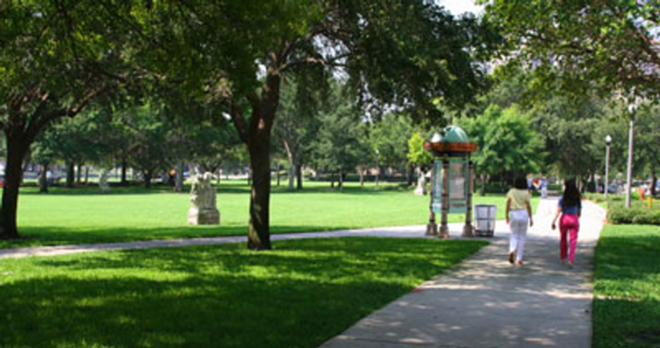
On a park bench in St. Pete, a tanned, bearded man with bright blue eyes gives voice to similar sentiments. Ferdinand Lupperger remembers the old days when he was able to rent a garage apartment in the area for $285 a month. Now, after a series of odd jobs and a raft of health problems, he finds himself in need of aid in an expensive boomtown. "They're tearing down all these buildings that could be turned into shelter that could help people like me," he says. "That's the way the city's working. They're not working to help us, they're working to hurt us."
GETTING AROUND
Transportation in the two downtowns is like most other aspects of the urban areas: a work in progress. Every day, thousands of commuters fight the traffic, pour into Tampa and St. Pete, and hunt down scarce parking. (As an example, more than 66,000 people work in downtown Tampa, which has just 22,000 public parking spaces.)
For now, getting around the downtowns mean using your feet or riding the bus, with St. Pete being much more hospitable to walkers. Taxi availability has been improving in St. Pete, but in Tampa the likelihood of hailing a cab away from the convention center is remote. Fortunately, both downtowns are well-served by bus systems (HARTline in Tampa, PSTA in St. Pete). For example: HARTline's route 96 makes a circle around downtown Tampa, from the Waterside Marriott, up Florida Avenue through the Marion Transit center and back down Tampa Street. On hot summer days, the air-conditioned bus beats walking through Tampa's glass and concrete furnace.
If you're in the right spot in downtown Tampa (near the Convention Center or Channelside), taking the electric streetcar is also a viable option. Tampa's streetcar system, which travels from downtown to Ybor City and back, is still empty during the week save the occasional tourist. Ridership may soon increase, as the system is poised to transport Channelside's soon-to-be condo dwellers to their downtown offices. (Two new stops are slated to open when the condos are done.) And a planned Hyde Park expansion could increase the number of commuters coming from the other side of downtown. Whether the streetcar will ever actually become a relied-upon form of mass transit in Tampa is still an open question.
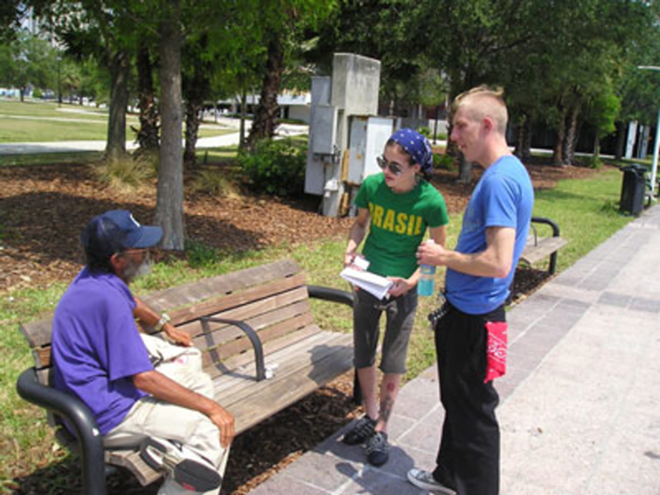
St. Pete's Looper trolley service seems doomed to a life of shuttling tourists and the elderly around. Despite a route that traverses much of the downtown area, it's hard to picture people coming and going from their jobs, listening to the same lame tour dialogue day after day. It's hard, however, to beat the price. The Looper costs a quarter (10 cents for the disabled and seniors).
It says much about the Bay area that mass-transit options in both downtowns are wrapped in the cloak of a tourist attraction.
THE BIG BOOM
The construction cranes tell the story. The condo craze, having swept through Miami and South Florida, hit Tampa Bay in the past five years. It is fueled mostly by foreign investors and speculators who have seen huge profits by flipping properties, buying them cheap before they are built and selling them at a gain without ever living in the units.
In St. Petersburg, the list of residential projects either proposed or under way runs four printed pages. Superdeveloper Grady Pridgen has two projects with 676 condo units on the drawing board; prices range from $150,000 to $500,000. Signature is just a cleared lot right now, but its developer, Joel Cantor, has unveiled an architecturally spectacular wedge where home prices will go from $350,000 to $4 million for the penthouse. Loftsville. W-Plaza. Ovation. Urban Village One. 1010 Central Avenue. The Sage. Urban Edge. The names — and the signs on chain link fences throughout downtown St. Petersburg — go on seemingly forever.
St. Pete has a few advantages that Tampa doesn't, and it shows in all the construction going on already. Downtown St. Petersburg is designated as a historic neighborhood, giving tax breaks for some projects. Its city blocks are bigger, allowing for more units with lower heights than Tampa's relatively tiny downtown lots. Its downtown is also bigger overall, stretching for miles in each direction vs. Tampa's compact 760 acres.
Tampa is just beginning to populate its downtown. Just 600 people currently live there, according to the Tampa Downtown Partnership. That number is expected to double by 2007; 2,282 units are under construction, and another 3,336 are proposed. (Banking sources and economics say that many of the proposed units in both downtowns will never become reality. Even the marquee Tampa Trump Tower project is the subject of endless debate and rumor-mongering as to whether it will indeed come out of the ground.)
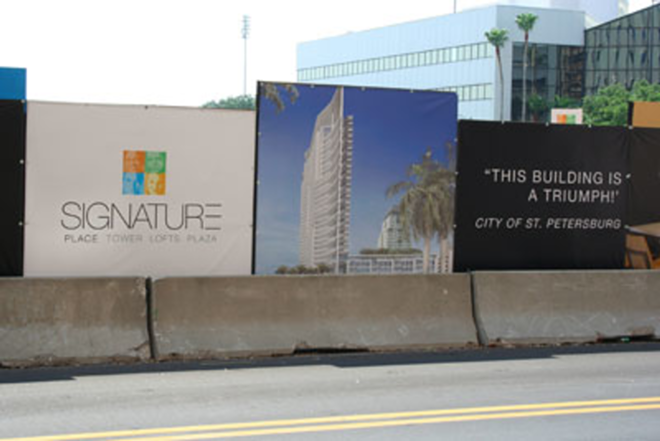
The first out of the ground in Tampa is Skypoint, with 54 percent of its homes priced below $250,000. On a weekday at lunch, its showroom is immaculate, high tech and awe-inspiring — if devoid of potential customers. The project — with the slogan "Touch the clouds. Own the sky. Soar." — is sold out. Most of the folks who drop in these days are already owners, showing off their floor plans to friends and relatives.
Skypoint's developer, Greg Minder, says his project was designed with the urban core in mind; affordable to young buyers, designed with common areas for socializing, with a strong interface to the street. He distinguishes that kind of urban condo from the ubiquitous "Florida beach" condo, in which high-end buyers have little interest in an urban experience. Many of the condos proposed or going into both downtowns are of the beach variety, leading some downtown observers to wonder if they will truly contribute to the urban neighborhood.
Though Minder's project is sold out, he is planning two more towers just to the east of Skypoint. "How many people want urban living?" he said. "Well, we're not sure yet."
This story was reported by Anne Arsenault, Joe Bardi, Wayne Garcia, Scott Harrell, Leslie Paredes, Alex Pickett, Leilani Polk, Eric Snider, C.J. Tropp, David Warner and Anna Wood. It was written by Wayne Garcia.


